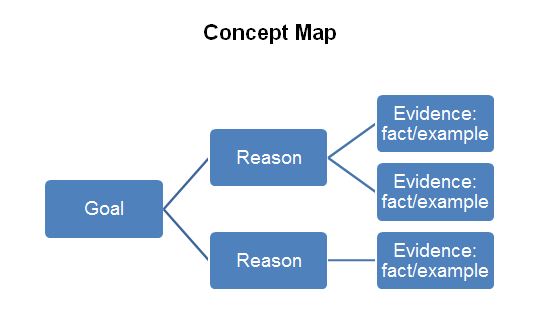Persuasive Writing Content Module
Jhunsucker (Talk | contribs) (→Prepare for Landing) |
Jhunsucker (Talk | contribs) (→Idea to support vocabulary learning) |
||
| Line 40: | Line 40: | ||
==Idea to support vocabulary learning== | ==Idea to support vocabulary learning== | ||
Use visual representations or actions to explain persuasion and related terms. For example, the following images may be shared to teach the words 'argue', 'claim', and 'counter argument'. | Use visual representations or actions to explain persuasion and related terms. For example, the following images may be shared to teach the words 'argue', 'claim', and 'counter argument'. | ||
| − | + | ||
| + | [[File:Persuasive Writing.jpg]] | ||
=Floating on Air= | =Floating on Air= | ||
Revision as of 15:59, 23 August 2013
Contents |
Plot the Course
CCSS.ELA-Literacy.CCRA.W.1 Write arguments to support claims in an analysis of substantive topics or texts using valid reasoning and relevant and sufficient evidence.
- CCSS.ELA-Literacy.CCRA.W.4 Produce clear and coherent writing in which the development, organization, and style are appropriate to task, purpose, and audience.
- CCSS.ELA-Literacy.CCRA.W.5 Develop and strengthen writing as needed by planning, revising, editing, rewriting, or trying a new approach.
- CCSS.ELA-Literacy.CCRA.W.6 Use technology, including the Internet, to produce and publish writing and to interact and collaborate with others.
- CCSS.ELA-Literacy.CCRA.W.1 Write routinely over extended time frames (time for research, reflection, and revision) and shorter time frames (a single sitting or a day or two) for a range of tasks, purposes, and audiences.
* Note: While W.1 is the main standard associated with this module, standards 4, 5, 6, and 10 should be considered when planning instruction.
The rationale
The ability to communicate effectively is a necessary lifelong skill. In fact, "writing skill is a predictor of academic success and a basic requirement for participation in civic life and in the global economy" (Graham & Perin, 2007, p.3). According to Graham and Perin, "all students need to become proficient and flexible writers" (2007, p.7). However, writing instruction has typically been neglected (National Commission on Writing, 2003, p.9). With the recent adoption of the Common Core State Standards (CCSS; National Governors Association \[NGA\] & Council for Chief State School Officers \[CCSSO\], 2010) in forty-five states, there is a renewed emphasis on writing instruction. The CCSS specify three main types of writing: narrative, informational, and argumentative. This module will focus specifically on persuasive writing. In the Common Core Standards, the word "opinion" is used through 5th grade and then changes to argument for 6th grade and beyond.
Module Goal
The goal of this module is to provide detailed information on persuasive writing to teachers of students with disabilities at the elementary and middle school level. This module aims to provide teachers with a general overview of these concepts as well as teaching suggestions so that a teacher can begin to plan instruction for these concepts. Additionally, this module provides instructors with potential adaptations and modifications to consider when designing materials and instruction for students with severe disabilities.
Module Objectives
After viewing the content module, teachers will:
- Develop understanding of essential principles of effective writing instruction that encourages both the writing process and persuasive writing products.
- Be familiar with persuasive writing features and instructional strategies to teach students to effectively develop persuasive writing skills.
This module is organized using the following sections: Time for Take Off, Floating on Air, and Prepare for Landing. Key vocabulary is provided in the "Time for Take Off" section of the module. Connections to the Common Core State Standards and PowerPoint presentations containing information and instructional suggestions for teaching about persuasive writing are shared in the "Floating on Air" component. In "Prepare for Landing", strategies to review, reinforce, and apply persuasive writing to real world connections are provided.
Time for Take Off
Understanding the vocabulary used with persuasive writing is important for both teachers and students in planning and implementing writing lessons. As a teacher, knowing and using the terms not only ensures your instruction stays true to the content, but will also help with collaborating with other writing teachers or literacy experts. When choosing which vocabulary to teach, it is most important that the teacher selects the most salient, important, or most frequently used vocabulary for each lesson.
Below you will find a list of vocabulary related to this module. It may or may not be necessary to provide instruction for all terms as students may have learned them previously. If you are a secondary teacher and are not confident your students have been taught these vocabulary terms, you may want to review and teach those unknown terms during the focus and review section of your lesson plan.
While providing vocabulary instruction, you may consider including pictures or objects to make the instruction more concrete for students with disabilities (See Ideas to support vocabulary learning below).
Vocabulary
- persuade – try to convince somebody about something
- argument – a reason for or against something
- reason – a statement given to explain a belief or act
- evidence – something that gives a sign or proof of the truth or helps someone come to a particular conclusion
- support – to promote interest or cause
- claim – an assertion that something is true
Idea to support vocabulary learning
Use visual representations or actions to explain persuasion and related terms. For example, the following images may be shared to teach the words 'argue', 'claim', and 'counter argument'.
Floating on Air
Before you can begin teaching your students about persuasive writing, it is important that you first have a deep understanding of the information. Some of the concepts may be familiar to you. Below is a list containing Standard W.1 and SL.4 from the Common Core State Standards for grades K-8. You will also find a series of PowerPoint presentations containing information, examples, and instructional suggestions below the chart.
ELA Common Core State Standard W.1 and SL.4: Narrative Writing - Grades K-8
| K | W.1 Use a combination of drawing, dictating, and writing to compose opinion pieces in which they tell a reader the topic or the name of the book they are writing about and state an opinion or preference about the topic or book (e.g., My favorite book is...).
SL.4 Describe familiar people, places, things, and events and, with prompting and support, provide additional detail. |
| 1 | W.1 Write opinion pieces in which they introduce the topic or name the book they are writing about, state an opinion, supply a reason for the opinion, and provide some sense of closure.
SL.4 Describe people, places, things, and events with relevant details, expressing ideas and feelings clearly. |
| 2 | W.1 Write opinion pieces in which they introduce the topic or book they are writing about, state an opinion, supply reasons that support the opinion, use linking words (e.g., because, and, also) to connect opinion and reasons, and provide a concluding statement or section.
SL.4 Tell a story or recount an experience with appropriate facts and relevant, descriptive details, speaking audibly in coherent sentences. |
| 3 | W.1 Write opinion pieces on topics or texts, supporting a point of view with reasons.
SL.4 Report on a topic or text, tell a story, or recount an experience with appropriate facts and relevant, descriptive details, speaking clearly at an understandable pace. |
| 4 | W.1 Write opinion pieces on topics or texts, supporting a point of view with reasons and information.
SL.4 Report on a topic or text, tell a story, or recount an experience in an organized manner, using appropriate facts and relevant, descriptive details to support main ideas or themes; speak clearly at an understandable pace. |
| 5 | W.1 Write opinion pieces on topics or texts, supporting a point of view with reasons and information.
SL.4 Report on a topic or text or present an opinion, sequencing ideas logically and using appropriate facts and relevant, descriptive details to support main ideas or themes; speak clearly at an understandable pace. |
| 6 | W.1 Write arguments to support claims with clear reasons and relevant evidence.
SL.4 Present claims and findings, sequencing ideas logically and using pertinent descriptions, facts, and details to accentuate main ideas or themes; use appropriate eye contact, adequate volume, and clear pronunciation. |
| 7 | W.1 Write arguments to support claims with clear reasons and relevant evidence.
SL.4 Present claims and findings, emphasizing salient points in a focused, coherent manner with pertinent descriptions, facts, details, and examples; use appropriate eye contact, adequate volume, and clear pronunciation. |
| 8 | W.1 Write arguments to support claims with clear reasons and relevant evidence
SL.4 Present claims and findings, emphasizing salient points in a focused, coherent manner with relevant evidence, sound valid reasoning, and well-chosen details; use appropriate eye contact, adequate volume, and clear pronunciation. |
Check for understanding. Click on the PowerPoints below.
\[Insert Effective Writing Instruction PowerPoint here\]
\[Insert Persuasive Writing PowerPoint here\]
Great! Now that you have viewed the PowerPoint presentations, the next section will provide some ideas to consider when planning for universal design for learning.
Effective Writing Instruction PowerPoint
Persuasive Writing Instruction PowerPoint
Sharing the Sky
UNIVERSAL DESIGN FOR LEARNING
| Visual Impairment or Deaf/Blind | Physical Impairment:
Little/ No Hand Use |
Lacks Basic Concepts | Motivational/ Attention Issues | |
| Representation | Engage in oral rehearsal of persuasive writing; use a talking device such as an avatar; use large font to type; use online tools to create graphic organizers (i.e., Readwritethink.org); use picture cards and graphic organizers to organize persuasive piece; digital writing modes (MovieMaker, iMovie). | Student scans an array of possible options and uses a switch to select topic, reasons, audience, etc.; use computer representation that can be manipulated with switch; place key aspects on a slant board or eye gaze board; create an exercise in the classroom that the student can walk or ride in wheelchair to persuade or convince their peers. | Offer scaffolding to assist students with writing. Use graphic organizers and sentence starters. Offer images and illustrations as springboards for ideas. Read text with basic structure to show examples to students. After reading, encourage students to complete a backwards plan to highlight key aspects of the persuasive text. | Use motivating objects to persuade (i.e., puppets or student's favorite character, object, etc.). Incorporate technology including computer representations, videos, animations, and talking avatar. Allow students to self-select writing paper, tools, and topics for writing. |
| Expression | Student selects topic from limited options (i.e., offer 2-3 choices); use voice output devices for student to select aspects such as topic, purpose, reasons, audience; teach tangible symbols for these components. | Uses a switch to indicate key aspects such as topic, purpose, reasons, audience from a limited selection; use an eye gaze board to select key aspects; use a blink response to select key aspects from a limited selection; phrase questions so that they require a "yes/no" response, these can easily be answered using an eye gaze, head turn, two switches, etc. | Student selects pre-made cards with key aspects such as topic, purpose, reasons, and audience versus writing them; writing is done after a model; student answers "yes/no" questions. | Have students write using drawings, interactive computer programs, acting out with props, etc. |
| Engagement | Teach students to use their hands to scan objects; use talking avatars or prompts to elicit student writing; allow students to select their writing materials (i.e., paper, writing utensils) and online websites to generate writing; encourage students to develop writing that is familiar and reinforcing to students. | Use a computer with AT where the student can click to select various aspects of persuasive writing; use cards that are large enough to accommodate the movements that the student is able to make; pair student with another student without a physical impairment and have them work together to write and discuss writing. | Student uses websites and listening centers that read aloud text. Use puppets and objects to develop writing. Provide students with real experiences to inspire writing (i.e., intentionally drop a piece of trash on the floor to discuss littering, etc.) | Create games in which students interact with partners to persuade one another about a given topic.
Create text and scenarios that involve the students and their interests and experiences. |
Prepare for Landing
Below you will find ideas for linking persuasive writing to real-world applications, the college and career readiness skills addressed by teaching these concepts, module assessments for teachers, sample general education lesson plans incorporating Universal Design for Learning framework, blog for teachers to share their ideas, and a place to upload and share lesson plans from teachers who completed this module. One way to help assist in a special educator's development within this curricular area is through collaboration with other teachers in your building. Often these skills are practiced outside of an ELA classroom in other curricular areas as well as during everyday tasks. Some activities with real world connection include:
- Associate persuasive writing skills learned in class to wide reading and real world texts by teaching students to read as writers to notice author's craft. This allows the students to apply the learning to real reading experiences. This supports students' understanding of the relevance of content and will increase comprehension and writing skills.
- Encourage students to engage in class debates.
- Encourage students to self-select topics to write about based on interest and topics they are passionate about. This will increase motivation and engagement in the writing process.
- Using and discussing key vocabulary words that might not be common in students' everyday talk can begin to extend students' oral language skills, which will also enhance their writing skills.
In addition to the real-world applications of these concepts, skills taught within this content module also promote the following college and career readiness skills:
Communicative competence Students will increase their vocabulary to include concepts related to "persuasive writing." Specifically, they will be learning concepts such as: "argument," "reason," and "evidence".
Fluency in reading, writing, and math Students will have opportunities to enhance their writing skills and comprehension as their awareness of persuasive writing increases. By having stronger knowledge about persuasive writing, students will be able to develop focused, well-organized, and detailed pieces of writing. They will also enhance their reading abilities since reading and writing are reciprocal processes.
Age appropriate social skills Students will engage in peer groups to discover and discuss persuasive texts, engage in debates, and share their persuasive writing. Independent work behaviors Students will engage in independent writing. They will have an increased understanding of persuasive writing through opportunities to engage in authentic writing experiences.
Skills in accessing support systems At times, students will need to ask for assistance to complete activities related to "persuasive writing" which will give them practice in accessing supports. Students will gain practice asking for help with persuasive writing as needed. They can ask a peer to complete the physical movements of the tasks they are not able to do themselves. Be sure to teach students to ask versus having items or supports automatically given to them.
In addition to collaborating with other educational professionals in your building, the following list of resources may also help provide special educators with ideas for activities or support a more thorough understanding of the concepts presented in this content module.
Additional Resources
Empowering Writers (2012). Retrieved June 30, 2013 from http://empoweringwriters.com/improving-student-writing/persuasive-writing/. Empowering Writers lays out the purpose of teaching students persuasive writing, the right time to teach persuasive writing and how persuasive writing compares to expository writing.
National Writing Project (2013). Retrieved June 23, 2013 from http://www.nwp.org. The National Writing Project provides articles, lessons, support, and professional development in the area of improving writing and learning across the nation's schools.
Read and Write with Rebecca (2012). Retrieved June 20, 2013 from http://www.readandwritewithrebecca.com. Rebecca Shoniker offers resources for teachers, coaches, and parents of readers and writers of all ages.
ReadWriteThink (2013). Retrieved June 29, 2013 from http://www.readwritethink.org/professional-development/strategy-guides/persuasive-writing-30142.html. This site provides teachers with strategies on ways to get students connected with persuasive writing allowing them to express their needs and desires.
ReadWriteThink (2013). Retrieved June 29, 2013 from http://www.readwritethink.org/professional-development/strategy-guides/developing-persuasive-writing-strategies-30965.html. This resource guide focuses on Developing Persuasive Writing Techniques to use in your classroom as you guide students through the understanding of using persuasive writing.
References
Bomer, K., & Bomer, R. (2001). For a better world: Reading and writing for social action. Portsmouth, NH: Heinemann.
Caine, K. (2008). Writing to persuade: Mini-lessons to help students plan, draft, and revise. Portsmouth, NH: Heinemann.
Calkins, L., Ehrenworth, M., & Lehman, C. (2012). Pathways to the common core: Accelerating achievement. Portsmouth, NH: Heinemann.
Carroll, J. A., & Wilson, E. E. (2008). Acts of teaching: How to teach writing. Portsmouth, NH: Heinemann.
Common Core State Standards Initiative. (2010). Common Core State Standards: Preparing America's students for college and career. Retrieved January 2, 2013 from http://www.corestandards.org/assets/Appendix_C.pdf
Gallagher, C. W., & Lee, A. (2008). Teaching writing that matters. New York, NY: Scholastic. This text offers tools and projects that motivate adolescent writers.
Graham, S., & Perin, D. (2007). Writing next: Effective strategies to improve writing of adolescents in middle and high schools – A report to Carnegie Corporation of New York. Washington, DC: Alliance for Excellent Education.
National Commission on Writing. (2003). The neglected "r": The need for a writing revolution. New York: College Entrance Examination Board.
Picard-Taylor, S. (2008). A quick guide to teaching persuasive writing K-2. Portsmouth, NH: Heinemann.
Ray, K. W. (2006). Exploring inquiry as teaching stance in the writing workshop. Language Arts, 83, 3, 238-247. An inquiry approach to genre study that repositions curriculum as the outcome of instruction rather than as the starting point.
Module Assessments
[Insert -http://coedpages.uncc.edu/cpflower/cmod/elementary assessment.docx]assessment here
Sample General Education lesson plans
Insert Persuasive Writing lesson with UDL Persuade Me! (2013). Retrieved June 29, 2013 from http://www.kn.att.com/wired/fil/pages/listpersuasid.html. Persuade Me! offers teachers resources on planning persuasive writing pieces, examples of activities to utilize in your classroom and other resources.
ReadWriteThink (2013). Retrieved June 29, 2013 from http://www.readwritethink.org/classroom-resources/student-interactives/persuasion-30034.html. This link provides students with an interactive graphic organizer allowing them to map out their arguments in a way beyond using just paper and pencil. Sample lessons for grades K-12 are provided on how to use this interactive resource.
ReadWriteThink (2013). Retrieved June 30, 2013 from http://www.readwritethink.org/classroom-resources/lesson-plans/convince-developing-persuasive-writing-56.html. This lesson, Can You Convince Me?, allows grades 3-5 students to focus on skills and knowledge they already have to hold persuasive arguments as they prepare to dig deeper with their persuasive writing.
Scholastic (2013). Retrieved June 30, 2013 from http://www.scholastic.com/browse/collection.jsp?id=659 . Scholastic offers a variety of lesson plans for teachers of all grade levels to support persuasive writing in their classrooms. This link also includes sample printables that will further support student work.
WritingFix (2012). Retrieved June 29, 2013 from http://writingfix.com/genres/persuasive.htm. The Writing Fix website is sponsored by the Northern Nevada Writing Project (NNWP). This direct link will take you to lessons and resources on persuasive writing from one of NNWP's in-service classes.
Have an idea: Upload the lesson plans you've created here
Insert link for teachers to upload lesson plans
Teacher's Corner: Blog with other teachers
Insert forum or blog for teachers to share ideas Adapt the following general education lesson plan, and upload. These lesson plans may be shared with higher education professionals developing strategies to provide meaningful academic instruction in ELA to students with severe disabilities. Insert Up for the Challenge lesson Insert link for teachers to upload lesson plans
Persuasive Writing Assessment
True or False
- The purpose of persuasive writing is to tell a story. TRUE FALSE
- It is important for students to write for authentic purposes and real audiences. TRUE FALSE
- Graphic organizers are an effective way to teach persuasive writing. TRUE FALSE
- Which of the following is a purpose of persuasive writing?
- Tells a story.
- Provides factual information to describe, sequence or compare.
- Put forward a point of view or justify a position.
- None of the above
- Why is it important to teach persuasive writing?
- It provides students with an opportunity to their have voices heard.
- It teaches students to develop as active citizens and to think independently.
- Students can move beyond the four walls of the classroom and become more thoughtful about the larger world around them.
- All of the above
- All of the following make a good persuasive writing piece except:
- The writer provides research as evidence.
- The writer entertains the reader with engaging dialogue between characters.
- The writer provides strong arguments as support.
- The writer uses illustrations, photographs and diagrams to convince the reader.
- Persuasive writing text structure includes which of the following components?
- Begin with an opening statement that tells readers what is being argued or what the topic is about.
- Provide reasons or arguments to support the given stance.
- Support with facts and opinions.
- All of the above
- Which of the following is not a type of persuasive writing?
- Recipes
- Editorials
- Advertisements
- Advice columns
- Name at least one effective instructional strategy for teaching persuasive writing.
Correct feedback: Yes, this answer is false. The purpose of persuasive writing is to convince someone to agree with your viewpoint or a cause.
Incorrect feedback: Nice try! This answer is false. The purpose of persuasive writing is to convince someone to agree with your viewpoint or a cause. Please review the persuasive writing module.
Correct feedback: Yes, this answer is true. It is important for students to write for authentic purposes and real audiences.
Incorrect feedback: Nice try! This answer is true. It is important for students to write for authentic purposes and real audiences. Please review the persuasive writing module.
Correct feedback: Yes, this answer is true. Graphic organizers are an effective way to teach persuasive writing.
Incorrect feedback: Nice try! This answer is true. Graphic organizers are an effective way to teach persuasive writing. Please review the persuasive writing module.
Multiple Choice
Correct feedback: Yes, putting forward a point of view or justifying a position is a purpose of persuasive writing.
Incorrect feedback: Nice try! Putting forward a point of view or justifying a position is a purpose of persuasive writing. Please review the persuasive writing module.
Correct feedback: Yes, all of the choices listed above are reasons why it's important to teach persuasive writing.
Incorrect feedback: Nice try! All of the choices listed above are reasons why it's important to teach persuasive writing. Please review the persuasive writing module.
Correct feedback: Yes, all of the choices listed above are reasons why it's important to teach persuasive writing.
Incorrect feedback: Nice try! All of the choices listed above are reasons why it's important to teach persuasive writing. Please review the persuasive writing module.
Correct feedback: Yes, all of the choices listed above are components of persuasive writing text structure.
Incorrect feedback: Nice try! All of the choices listed above are components of persuasive writing text structure. Please review the persuasive writing module.
Correct feedback: Yes, recipes are not a type of a persuasive writing.
Incorrect feedback: Nice try! Recipes are not a type of a persuasive writing. Please review the persuasive writing module.
Fill in the Blank
Correct feedback: Yes, an effective instructional strategy for teaching persuasive writing may include teacher modeling, graphic organizers, and studying author's craft to name a few.
Incorrect feedback: Nice try! An effective instructional strategy for teaching persuasive writing may include teacher modeling, graphic organizers, and studying author's craft. Please review the persuasive writing module.Persuasive Writing Assessment Key
True or False
- The purpose of persuasive writing is to tell a story. FALSE
- It is important for students to write for authentic purposes and real audiences. TRUE
- Graphic organizers are an effective way to teach persuasive writing. TRUE
- Which of the following is a purpose of persuasive writing?
- Tells a story.
- Provides factual information to describe, sequence or compare.
- Put forward a point of view or justify a position.
- None of the above
- Why is it important to teach persuasive writing?
- It provides students with an opportunity to their have voices heard.
- It teaches students to develop as active citizens and to think independently.
- Students can move beyond the four walls of the classroom and become more thoughtful about the larger world around them.
- All of the above
- All of the following make a good persuasive writing piece except:
- The writer provides research as evidence.
- The writer entertains the reader with engaging dialogue between characters.
- The writer provides strong arguments as support.
- The writer uses illustrations, photographs and diagrams to convince the reader.
- Persuasive writing text structure includes which of the following components?
- Begin with an opening statement that tells readers what is being argued or what the topic is about.
- Provide reasons or arguments to support the given stance.
- Support with facts and opinions.
- All of the above
- Which of the following is not a type of persuasive writing?
- Recipes
- Editorials
- Advertisements
- Advice columns
- Name at least one effective instructional strategy for teaching persuasive writing.
Correct feedback: Yes, this answer is false. The purpose of persuasive writing is to convince someone to agree with your viewpoint or a cause. Incorrect feedback: Nice try! This answer is false. The purpose of persuasive writing is to convince someone to agree with your viewpoint or a cause. Please review the persuasive writing module.
Correct feedback: Yes, this answer is true. It is important for students to write for authentic purposes and real audiences. Incorrect feedback: Nice try! This answer is true. It is important for students to write for authentic purposes and real audiences. Please review the persuasive writing module.
Correct feedback: Yes, this answer is true. Graphic organizers are an effective way to teach persuasive writing. Incorrect feedback: Nice try! This answer is true. Graphic organizers are an effective way to teach persuasive writing. Please review the persuasive writing module.
Multiple Choice
Correct feedback: Yes, putting forward a point of view or justifying a position is a purpose of persuasive writing. Incorrect feedback: Nice try! Putting forward a point of view or justifying a position is a purpose of persuasive writing. Please review the persuasive writing module.
Correct feedback: Yes, all of the choices listed above are reasons why it's important to teach persuasive writing. Incorrect feedback: Nice try! All of the choices listed above are reasons why it's important to teach persuasive writing. Please review the persuasive writing module.
Correct feedback: Yes, all of the choices listed above are reasons why it's important to teach persuasive writing. Incorrect feedback: Nice try! All of the choices listed above are reasons why it's important to teach persuasive writing. Please review the persuasive writing module.
Correct feedback: Yes, all of the choices listed above are components of persuasive writing text structure. Incorrect feedback: Nice try! All of the choices listed above are components of persuasive writing text structure. Please review the persuasive writing module.
Correct feedback: Yes, recipes are not a type of a persuasive writing. Incorrect feedback: Nice try! Recipes are not a type of a persuasive writing. Please review the persuasive writing module.
Fill in the Blank
Answers may include but are not limited to: Teacher modeling, Graphic Organizers, and Studying Author's Craft with mentor texts.
Correct feedback: Yes, an effective instructional strategy for teaching persuasive writing may include teacher modeling, graphic organizers, and studying author's craft to name a few.
Incorrect feedback: Nice try! An effective instructional strategy for teaching persuasive writing may include teacher modeling, graphic organizers, and studying author's craft. Please review the persuasive writing module.General Education ELA Lesson Plan: Persuasive Writing
Source: N/A Standard: CCSS.ELA-Literacy.CCRA.W.1 Write arguments to support claims in an analysis of substantive topics or texts using valid reasoning and relevant and sufficient evidence. Learning Outcome: Students will develop reasons to support their persuasive writing topics.
Materials:
- Mentor Text such as Can I Keep Him? by Stephen Kellogg, I Wanna New Room by Karen Kaufman Orloff, or I Wanna Iguana by Karen Kaufman Orloff
- chart paper or smart board
- writing paper/pencils
Activities:
- Focus and Review: Review previous learning such as writing letters to persuade someone to do something. Explain that it is important to consider audience and purpose for our persuasive writing.
- Teacher Modeling/Direct Instruction: Explain that today you will teach them to develop their writing by adding reasons. Remind them that to persuade means to convince someone and that adding reasons helps to support our claims. Provide students with an example. Point out important linking words such as 'because' and 'for this reason.'
- Guided Practice: Set the children up to practice the strategy with support. Ask students to turn and talk with a partner to share a reason they could include in their persuasive letter.
- Independent Practice: Before sending students off to work on their own writing, remind them that they will find their own process. Some of them will be brainstorming ideas while others will have an idea and will go off to begin writing about it. The goal is to be thinking and writing during the entire independent writing time. (Tip – You may want to set a timer so students can be aware of their writing stamina and set goals accordingly).
Activity: Create a universally designed version of the above lesson
| UDL Planning | My ideas |
| Representation - adaptations in materials (e.g., adapt for sensory impairments) | |
| Expression - how will student show learning (e.g., use of assistive technology; alternative project) | |
| Engagement - how will student participate in the activity |
General Education ELA Lesson Plan: Persuasive Writing
Source: N/A Standard: CCSS.ELA-Literacy.CCRA.W.1 Write arguments to support claims in an analysis of substantive topics or texts using valid reasoning and relevant and sufficient evidence. Learning Outcome: Students will consider audience and purpose as they begin brainstorming/writing about a persuasive topic.
Materials:
- Mentor Text such as Can I Keep Him? by Stephen Kellogg, I Wanna New Room by Karen Kaufman Orloff, or I Wanna Iguana by Karen Kaufman Orloff
- chart paper or smart board
- writing paper/pencils
Activities:
- Focus and Review: Introduce opinion writing by reading one of the mentor texts suggested above. In each of the suggested books, the child attempts to persuade their parents for something (i.e., a new room or a new pet). Use the mentor text as a springboard for discussion about the types of things students would ask their own parent/guardian for and create an anchor chart.
- Teacher Modeling/Direct Instruction: Explain to students that they can use writing to persuade someone. Tell them that persuade means to try to convince somebody about something. Then give an example. After reading a book above, discuss ways in which the character attempted to persuade another character. Explain that just like the character in the book, we too can use our voices through our writing to persuade someone. Discuss who we might want to persuade for something and create a list. Explain to students that we can write letters to persuade others.
- Guided Practice: Set children up to try the strategy. Ask students to turn and talk with a partner to share an idea they have for a persuasive letter.
- Independent Practice: Before sending students off to work on their own writing, remind them that they will find their own process. Some of them will be brainstorming ideas while others will have an idea and will go off to begin writing about it. The goal is to be thinking and writing during the entire independent writing time. (Tip – You may want to set a timer so students can be aware of their writing stamina and set goals accordingly).
Activity: Create a universally designed version of the above lesson
| UDL Planning | My ideas |
| Representation - adaptations in materials (e.g., adapt for sensory impairments) | Rather than having students brainstorm ideas in an open way with full choice which could potentially be overwhelming for some, provide them with story starters (images and sentences) to scaffold the brainstorming process; they could also draw pictures or orally tell their ideas. |
| Expression - how will student show learning (e.g., use of assistive technology; alternative project) | Students will successfully write (or sort pre-made picture cards) for audience, purpose, topic, and reasons in a graphic organizer; an extension would be to have students create their own picture card to represent their own topic and place within a graphic organizer or template. |
| Engagement - how will student participate in the activity | Student can work in pairs during independent practice; student can use technology (e.g., iPad) to practice drawing, writing, and thinking about ideas for writing. They can also work together to orally tell about their persuasive writing topics, audience, reasons, etc. Some students will need to simply use the peer time to brainstorm ideas before actually writing. |






